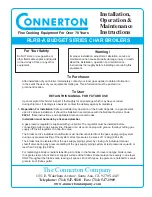
© The Fulton Companies 2012
INSTALLATION
RLN-IOM-2012-1205
SECTION 2
2-18
supplier of the venting.
3. Category I Installations, individual piping for each boiler: The pressure
drop of the exhaust piping (not including the air intake piping) should be
a negative during all possible operating conditions, between -0.02 and
-0.04”wc. Vertical rise in the exhaust pipe is typically required to achieve
the desired negative pressure.
¡
For Both Venting Confi guration Options
Adhere to the following:
1. The exhaust vent installer should be familiar with and adhere to the
National Fuel Gas Code, ANSI A233.1, Part 10 or any other applicable
provisions of local building codes.
2. The exhaust vent installer should follow the vent manufacturer’s
instructions for proper installation procedures.
3.
A tee/boot tee with a drain must be installed at the fi rst elbow from the
boiler fl ue outlet. There must be a minimum of 4” of water within a loop
style trap (loop diameter 4”). The loop style trap can be high temperature
silicone rated for 500 F (see Figure 9) and must be piped/pitched to drain
freely.
4.
The loop style trap must be fi lled with water before connecting it to the
exhaust pipe. It is important that this trap is periodically checked and
verifi ed that it remains fl ooded during regular operation of the equipment.
Failure to do this could result in fl ue gases leaking into the boiler room.
5. The condensate connection on the boiler should be piped into the stack
drain piping (see Figure 9). The pipe from the boiler directed to the drain
should be installed at a slope of ¼” per foot.
6. Ensure that condensate drain piping will not be exposed to temperatures
where water condensate will freeze in the lines.
¡
Common Air Intake and Exhaust Venting of Multiple Boilers
Combining multiple Reliance boilers into a common pipe for combustion air
supply, exhaust, or both is only permitted on a case by case basis and must be
accomplished with an engineered solution.
Adhere to the following:
1. The engineered solution must guarantee the prevention of fl ue gases
moving backwards through idle boilers. This is important to prevent
fl ue gases from entering the mechanical room (if sealed combustion is
not being used) and also to prevent fl ue gases from corroding the heat
exchanger and/or other components in the upper cabinet of the boiler.
2. Reliance boilers should not be common vented with other types of
equipment.
3. Fulton requires the use of a combustion air supply damper (which can be
provided shipped mounted on the boiler by Fulton and incorporated into
!
WARNING
All information in this manual is for
reference and guidance purposes,
and does not substitute for required
professional training, conduct,
and strict adherence to applicable
jurisdictional/professional codes and
regulations.
Use of automatic vent dampers
or barometric dampers with the
Reliance boiler in positive pressure
systems may result in exhaust leaking
into the boiler room.
4
CAUTION
Failure to slope the exhaust line
toward the drain with a pitch of at
least 1/4” per foot may result in a
condensate pocket, which can result
in an inoperative boiler.
Summary of Contents for Reliance 1000
Page 2: ......
Page 4: ...TheFultonCompanies2012 TABLEOFCONTENTS RLN IOM 2012 1205 0 2...
Page 42: ...TheFultonCompanies2012 OPERATION RLN IOM 2012 1205 SECTION3 3 12...
Page 50: ...TheFultonCompanies2012 MAINTENANCE RLN IOM 2012 1205 SECTION4 4 8...
Page 51: ......
Page 52: ......
Page 59: ......
















































